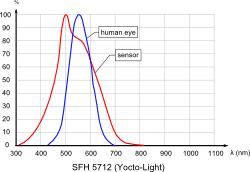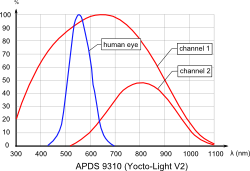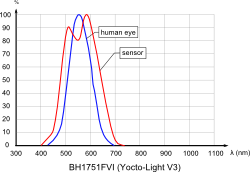![]() Some time ago, we had to stop making the Yocto-Light because the OSRAM light sensor that we used on this module stopped being produced. As a replacement, we now offer two products: the Yocto-Light-V2, more reactive, based on an AVAGO sensor, and the Yocto-Light-V3, truer to the human eye, based on a ROHM sensor. Let's see how they compare...
Some time ago, we had to stop making the Yocto-Light because the OSRAM light sensor that we used on this module stopped being produced. As a replacement, we now offer two products: the Yocto-Light-V2, more reactive, based on an AVAGO sensor, and the Yocto-Light-V3, truer to the human eye, based on a ROHM sensor. Let's see how they compare...
The basic function of the different versions of the Yocto-Light is to measure light. Not any kind of light, of course. We are interested in light that the human eye can see. This slight nuance has an enormous importance: the human eye is sensitive to a very specific light spectrum. If you want to perform a light measure corresponding to the impression a human would have, you must use an electronic sensor sensitive to the same spectrum, which is far from obvious to build.

Yocto-light: V1, V2 and V3
The OSRAM SFH-5712 sensor
The OSRAM sensor in the Yocto-Light directly gave a relatively good estimate of the eye response, as you can see below.

This sensor had nonetheless a few important drawbacks:
- It wasn't very reactive when measuring
- It wasn't designed to work outside the -15...70°C temperature range
- It wasn't able to measure low intensity lights (< 3 lux)
The AVAGO APDS-9301 sensor
The AVAGO sensor used in the Yocto-Light-V2 works somewhat differently. Rather than trying to precisely mimic the eye sensitivity spectrum, it is separately sensitive to two ranges of different spectra. One covers visible light very largely, the other the infrared. By combining the response amplitude on these two ranges, and by making a few assumptions on the expected light type, we can deduce which would have been the human eye response to this light.

Using two measures without a direct connection to the human eye sensitivity spectrum doesn't allow a perfect estimate of the eye response in the most general case. However, this sensor has some advantages:
- The sensor is much more reactive (10Hz in normal mode, up to 65Hz in fast mode)
- It works on a larger temperature range (-40...85°C)
- It can provide measures for very low intensities, below 0.1 lux
- It can provide explicit information on the light spectrum (visible vs. infrared)
The eye response approximation computed on the basis of these two measures has important limits. The formula proposed by AVAGO works well only on low intensities. For the Yocto-Light-V2, we have developed a more sophisticated interpolation formula than the one offered. It gives better results, often even better than for the first Yocto-Light, as long as intensity is not too high. In the opposite, as soon as the large spectrum probe of the AVAGO sensor is saturated, it's not possible to recognize the light type, and the value in lux is estimated making the assumption that it is the light of day. This computing mode change necessarily introduces a discontinuity in the light estimate in lux. This can raise important issues for some applications. We must therefore note the following fundamental drawback:
- In artificial light, the lux estimate is not very reliable above 16'000 lux (use the sensor raw values for a continuous measure)
The ROHM BH1751FVI sensor
The ROHM sensor used in the Yocto-Light-V3 works along the same principles as the OSRAM sensor. Its direct approximation of the human eye is event better than that of the OSRAM sensor:

Moreover, it has some advantages over the first Yocto-Light:
- It works on a more extended temperature range (-40...85°C)
- It is specified up to 100'000 lux, and you can even use it up to 120'000 lux in most cases
- It is able to measure low intensities going down to 0.25 lux
It has only one drawback compared to the Yocto-Light: it is a little bit more expensive (+2 USD/unit). But its advantages are worth that.
Which one should you use?
Here is a summary table to throw some light:
| Yocto-Light | Yocto-Light-V2 | Yocto-Light-V3 | |
|---|---|---|---|
| Sensor | OSRAM SFH-5712 | AVAGO APDS-9301 | ROHM BH1751FVI |
| Measuring range | 3...65'000 lux | 0...16'000 lux | 0...100'000 lux |
| Sensitivity up to | 0...80'000 lux | 0...60'000 lux | 0...120'000 lux |
| Resolution | 1 lux | <0.1 lux | 0.25 lux |
| Measuring frequency | 3 Hz | 10 Hz (65 Hz) | 4 Hz |
| Temperature range | -15...70°C | -30...85°C (-40°C for the sensor) | -30...85°C (-40°C for the sensor) |
Given this table, we recommend using the Yocto-Light-V2 only for the following applications:
- measures of low intensity lights
- detection of light signals and light barriers
- quantification of the luminosity of a known spectrum lighting
- discrimination between fluorescent/led and incandescent/daylight lights in ambient inside lighting
The Yocto-Light-V3 is much better suited for applications of the following types:
- measures of the ambient light inside and outside (in lux)
- any other application for which the Yocto-Light was more suited than the Yocto-Light-V2


